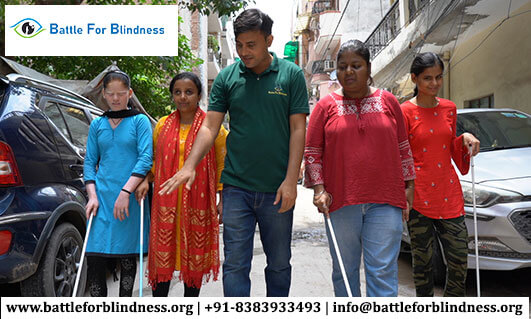
Acquired blindness refers to vision loss that occurs after birth due to various factors such as accidents, diseases, or environmental influences. Unlike congenital blindness, which is present at birth, acquired blindness develops later in life and can result from a range of causes. Understanding the risks and implementing preventive measures can help mitigate the impact of acquired blindness and promote better eye health.
What is Acquired Blindness?
Acquired blindness encompasses any significant loss of vision that occurs due to factors encountered after birth. This condition can result from trauma, infections, chronic diseases, or degenerative conditions affecting the eyes or the visual pathways in the brain. The severity of vision loss can vary from partial impairment to complete blindness, depending on the underlying cause.
Causes of Acquired Blindness
- Accidents and Trauma: Physical injuries to the eye, such as those sustained in accidents or sports, can lead to permanent vision loss. Common types of trauma include:
- Blunt Trauma: Impact injuries from objects or falls can damage the eye’s structures.
- Penetrating Injuries: Foreign objects or sharp objects can penetrate the eye, causing severe damage to the retina, lens, or cornea.
- Diseases and Infections: Various diseases and infections can lead to vision loss if left untreated or poorly managed. Some notable examples include:
- Diabetic Retinopathy: A complication of diabetes where high blood sugar levels damage the blood vessels in the retina, leading to vision impairment.
- Glaucoma: A group of eye conditions that damage the optic nerve, often associated with elevated intraocular pressure.
- Age-related Macular Degeneration (AMD): A degenerative condition that affects the macula, the part of the retina responsible for central vision.
- Infectious Diseases: Conditions such as bacterial or viral infections can cause significant eye damage and potential blindness if not addressed promptly.
- Chronic Conditions: Certain chronic health conditions can contribute to vision loss over time. For example:
- Hypertension: High blood pressure can lead to retinal damage and vision problems.
- Autoimmune Diseases: Conditions like lupus or rheumatoid arthritis can cause inflammation in the eyes, affecting vision.
- Degenerative Conditions: Progressive eye diseases that develop over time can lead to vision loss. These include:
- Retinitis Pigmentosa: A genetic disorder causing the gradual degeneration of the retina.
- Usher Syndrome: A genetic condition that combines hearing loss with progressive vision loss.
- Environmental Factors: Prolonged exposure to harmful environmental factors can also impact eye health:
- Ultraviolet (UV) Light Exposure: Excessive exposure to UV rays from the sun can increase the risk of cataracts and other eye conditions.
- Chemical Exposure: Contact with toxic chemicals or pollutants can damage the eyes and lead to vision problems.
Risks Associated with Acquired Blindness
Loss of Independence: Vision loss can significantly impact an individual’s ability to perform daily tasks, affecting their independence and quality of life.
Social and Emotional Impact: Acquired blindness can lead to feelings of frustration, depression, or isolation. The psychological effects of vision loss can be profound, impacting mental health and social interactions.
Educational and Employment Barriers: Vision impairment can create challenges in accessing education and maintaining employment, requiring special accommodations and support.
Increased Risk of Injury: Individuals with reduced vision may be at a higher risk of accidents and injuries due to difficulty navigating their environment.
Prevention and Mitigation Strategies
- Safety Measures: Implementing safety measures to prevent accidents and injuries can reduce the risk of acquired blindness. This includes:
- Using Protective Eyewear: Wearing safety goggles or glasses during activities that pose a risk to the eyes.
- Implementing Safety Protocols: Ensuring a safe environment at home and work to prevent accidents.
- Regular Eye Exams: Regular eye examinations can help detect and manage eye conditions early, reducing the risk of severe vision loss. Individuals with chronic conditions or risk factors should have more frequent eye check-ups.
- Managing Chronic Diseases: Proper management of chronic conditions such as diabetes and hypertension can help prevent complications that may lead to vision loss.
- Vaccinations and Hygiene: Preventing infections through vaccinations and maintaining good hygiene practices can reduce the risk of eye infections and related vision problems.
- UV Protection: Wearing sunglasses with UV protection can help shield the eyes from harmful sun exposure and prevent damage.
- Early Detection and Treatment: Seeking prompt medical attention for any signs of vision problems or eye injuries can help prevent further damage and preserve vision.
Conclusion
Acquired blindness, resulting from accidents, diseases, or environmental factors, presents significant challenges and impacts on individuals’ lives. By understanding the various causes and implementing preventive measures, we can reduce the risk of vision loss and support those affected. Regular eye care, safety precautions, and proactive management of health conditions are key to preserving vision and enhancing quality of life. With awareness and action, it is possible to mitigate the impact of acquired blindness and promote better eye health for everyone.





